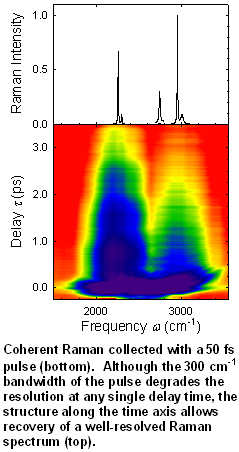
ACS PRF | ACS
All e-Annual Reports

45697-AC6
Water Structure Around Hydrophobic Solutes by Femtosecond 2D-Vibrational Spectroscopy
The interaction of solutes with water is unique: the hydrogen-bond network of water must be disrupted to accommodate the solute. The exact nature of that disruption depends on the details of the solute, and it determines processes such as solubility, hydrophobic attraction, self-assembly and protein folding. The purpose of this project is to develop and apply a new type of 2D vibrational spectroscopy to measure the distorted water structure around a solute in aqueous solution. This structure can be deduced from the Raman spectrum of the water in the first shell around the solute, or even better, the water in contact with a specific point within the solute. The problem is to isolate this water from the much larger amount of unperturbed water. The solution is to exploit the weak anharmonic coupling that develops when there is contact between vibrational groups on the solute and the water. A number of multi-dimensional vibrational spectroscopies have been developed in recent years that have the ability to look specifically at intermolecular vibrational coupling. All involve sequences of three or more pulses and produce signal only in the presence of some type of anharmonic coupling. A new sequence has been proposed to look at the current problem: a first infrared pulse is tuned to a solute vibration to create a vibrational coherence on the solute; a second infrared pulse is tuned to a combination band of the solute vibration and the water OH vibration – this pulse shifts the coherence to the OH frequency; a final visible pulse undergoes coherent Raman scattering from the OH coherence and measures the water spectrum. Because the shift of coherence between solute and water is only possible when contact creates coupling between the two, this sequence isolates the signal from the water in contact with the solute. In this sequence, femtosecond pulses are needed to separate the strong nonresonant background, which is instantaneous, from the resonant signals, which persist for up to several picoseconds. Raman detection is also needed, because the intense absorption of the OH stretch makes IR transmission negligible at this frequency. However, true femtosecond Raman has been considered an impossibility: a 300 cm-1 bandwidth for the pulses is required by the uncertainty principle, but good Raman spectra require resolution of a few cm-1. In the first stage of this project, we have solved this conundrum. The apparent conflict is only present, if detection is limited to one dimension – either time or frequency. By allowing simultaneous detection in both time and frequency, we have shown, both in theory and in practice, that Raman spectra can be measured with femtosecond pulses with no fixed limitation on resolution. The ability to measure coherent Raman spectra with femtosecond pulses is essential to this project. However, it also has potential application in a variety of other measurements that rely on coherent Raman scattering: CARS microscopy, surface-sum-generation spectroscopy, time-resolved photochemistry and tip-enhanced Raman scanning microscopy. In addition to improved time-resolution, femtosecond pulses offer increased signal size and discrimination against non-resonant background in these application. The next stage of this project is to implement the full pulse sequence, including infrared pulses. The required optical set-up has been designed, purchased and prototyped. The old set-up for the initial work on femtosecond Raman is now being replaced with the new set-up.
